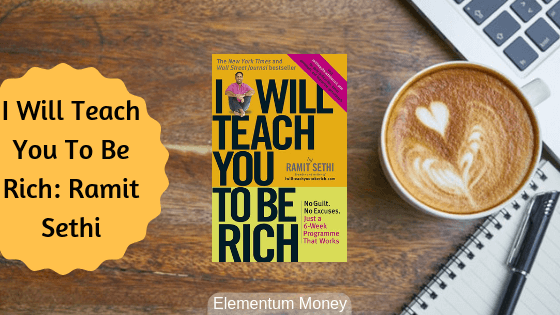
I will admit it. I have been a fan of Ramit Sethi and had first come across his website – I Will Teach You To Be Rich – quite some time back. From then on, I have also loved the Growth Lab and the courses for an online business that he has there. I have always looked wistfully at those wondering when I would be able to put together enough money to make it worth my while.
He is also one of the few people whose newsletters and emails I make a point to read. The copy is on point and most of the time his emails seem pretty insightful and seem to be backed by a Eureka moment. I think he does a good job at getting people to take action. For the same reason, I wanted to read his first claim to fame, his book I Will Teach You To Be Rich.
First Thoughts
The book can serve as the first port of call for someone who has not lifted a finger to think about Personal Finance. If paying attention to your money is something that hasn’t crossed your horizon ever, this book is for you.
The book makes the point very clear when it repeatedly claims that everybody is lazy when it comes to their money and the only way people will improve their financial lives is by making things automatic. In view of that, the main part of the book is laid out as a 6-week plan with each week dedicated to one aspect of our financial lives ending with some concrete action steps. While I agreed with most of it, as usual, the investing bit got my goat.
My bigger problem with the book was the tone of writing. Ramit seemed to talk from a lofty mountain looking down at the measly folk who have bought his book. There were instances when I thought he came across as unnecessarily rude and haughty and also trying too hard to be funny. With due credit, he does point out in between, that everybody does not get his jokes and I might just be one of them.
Six Week Plan
The introductory chapter of the book where Ramit sets the context, apart from the tone, is quite refreshing. Along with the obvious scapegoats of information glut and the financial media, what is interesting is the emphasis he puts on understanding the meaning of being rich. I agree with his view that being rich is very subjective and everyone needs to define what that looks like to be able to get to that destination. He also puts most of his focus on making one time tweaks and put in place good money habits.
Week 1
For Week 1, Ramit emphasizes credit scores and credit cards. Considering the fact that interest rates can vary widely on the basis of credit scores, he makes the valid point that a good credit score could save you much more than other small penny-pinching instances like cutting coupons (again more of an American phenomenon).
With credit cards, his perspective is refreshingly different. Unlike other Personal Finance gurus, he does not recommend cutting up the cards and going all cash. He points out the benefits like the reward points and ease of tracking spends at no annual fees only if you use them properly by paying the bill in full on time. For people already sucked into the trap of credit card debt, he gives them a 5-step route to paying it off.
Week 2
In the second week, it is all about understanding checking and saving accounts. While in India, the bifurcation between checking and saving is not really there, I think addressing these accounts was an important aspect considering they are the building blocks of Personal Finance. He also recommends savings accounts with digital banks which pay a higher rate of interest, as they save cost on logistics and infrastructure.
He recommends that the checking account is used only for personal expenses whereas you put in all the “Pay Yourself First” money in a savings account. Depending on how much complexity you want to handle in your financial life, you could choose a basic savings + checking formula whereas with more complexity you could define different buckets of savings to save for different financial goals. Ramit gives a fair number of checklist factors as to how to go about choosing a bank account. One point that he makes about not switching for a minuscule interest rate differential was pretty valid. A lot of switching costs are not visible right away and mostly not worth it for the tiny difference in interest rates.
Week 3
Considering there is no concept of 401 (k) in India, most of the time talking about this product goes over my head and eyes tend to glaze over. It happened with this chapter as well.
Week 4
The one concept that has stuck with me and wholly attributed to Ramit Sethi is the idea of conscious spending, the idea of making choices when it comes to money. The stepping stone here is the “Pay Yourself First” budget. Cut up your earnings into proportions for what you save and invest as well as what you are okay with spending. That’s an easy way to budget because then you end up limiting your total spending capacity anyway.
Now within the money that you have earmarked for spending in a month, a lot of it goes away unconsciously with things like automatically debited subscriptions for magazines of media streaming services that you might not even be using. The concept of conscious spending is all about clarity on the areas on life that you want to spend it at the cost of being frugal in all other areas, which at the heart of also means you are aware of each and every cent being spent. For instance, I might choose to not go to extravagant or flamboyant restaurants when dining out but instead save up and go traveling. Another example Ramit gives is of a friend who spends $5000 a year on shoes while cutting costs in all other areas of her life. Here is a good excerpt to tell you what conscious spending really means.
In the same week, apart from conscious spending, Ramit also gives ideas about well-planned saving. Taking into account the human tendency towards mental accounting, he suggests we open different accounts to save for different goals and label it similarly. In my consumer research as part of being a bank marketer, I have found a lot of people doing this anyway. So, if you can handle the complexity of multiple accounts, there might be merit to this idea.
Week 5
Week 5 was all about automating the flow of money from your checking account to your 401 (k) account. The idea is that defaults really work since humans are intrinsically lazy.
Week 6
This is probably the one chapter that I had a lot of grouse with. The chapter starts off well with hammering in the fact that no one can time the market and that most of the stock picking newsletters fail.
I think I just need to figure out more books which don’t keep telling me that index funds rock and everybody else is a fool. I understand that the angst against the financial services market is quite high in the US. However, I still believe there has to be some merit to the people out there. Also, all stocks are not equal and indices are made up only of large-cap stocks which mean lower risk and lower return. There are bound to be small-cap stocks worth taking the risk with.
The language is quite strong too. Sample this: If you’re even considering buying individual stocks because you think you can beat the market or it’s sexier, I want you to take all your money, put it in a big Ziploc bag along with this book, and light it on fire. Just save the middleman.
I believe individual stocks should be bought to get better returns over a longer period of time which rides out the volatility, not to beat the market. There is merit in value investing. All I could think of is that maybe the audience being written for is looking at excuses like “it’s too complicated” or that “it takes too much time or money” and for such people, the lowest common denominator method of index funds is the only possible solution.
Apart from this, he answers a few of the questions he has been asked like paying off student debt and saving for own wedding. All in all, I Will Teach You To Be Rich is a good read if you have no clue about Personal Finance and are walking around like a zombie with respect to your money. If somebody shouting at you gets you to do the job, no better person at it than Ramit Sethi with this book.
Have you read this book? What did you make of it? Let me know in the comments below.





Leave a Reply